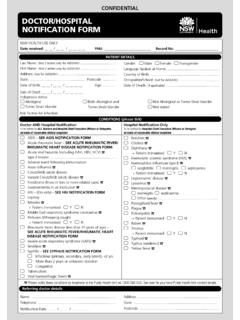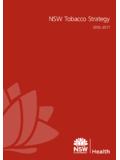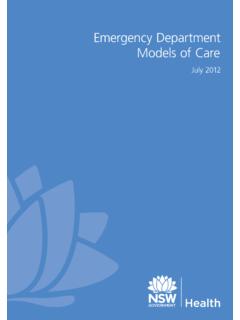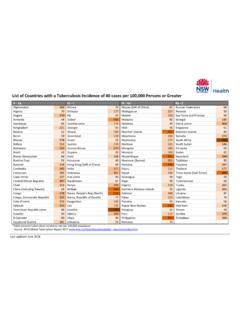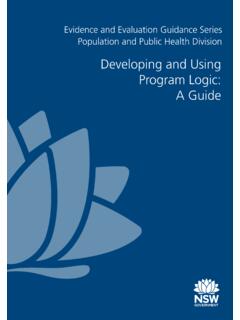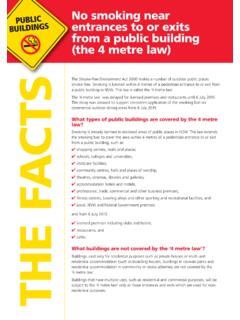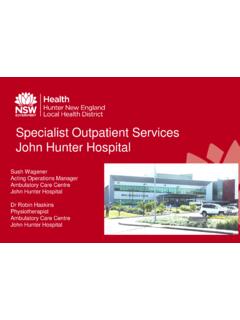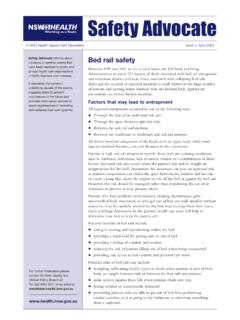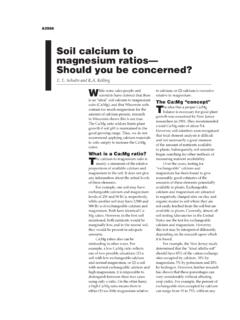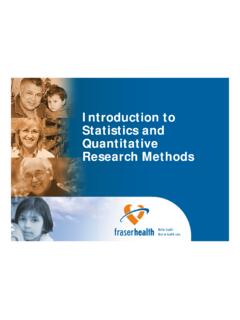Transcription of Prevention of falls in residential aged care
1 New South Wales Health Promotion Demonstration research Grants Scheme Prevention of falls in residential aged care Produced by: Centre for Health Advancement Population Health Division NSW DEPARTMENT OF HEALTH. 73 Miller St North Sydney NSW 2060 Australia Tel. (02) 9391 9000. Fax. (02) 9391 9101. TTY: (02) 9391 9900. This work is copyright. It may be reproduced in whole or part for study or training purposes subject to the inclusion of an acknowledgment of the source. It may not be reproduced for commercial usage or sale. Reproduction for purposes other than those indicated above requires written permission from the NSW Department of Health. NSW Department of Health 2009. Suggested citation: Ward J, Harden M, Gibson R, Byles J. Prevention of falls in residential aged care .
2 Sydney: NSW Department of Health, 2009. This is the report of a project sponsored by the New South Wales Health Promotion Demonstration research Grants Scheme funded by the NSW Department of Health. Cover images; SHPN (CHA) 0902123. ISBN 978 174 187 430 3. Further copies of this publication can be obtained from the NSW Department of Health website at: Disclaimer: Content within this publication was accurate at the time of publication. October 2009. Contents ii 5 12. Facility level List of tables and Return of Facility Monthly falls Data Abbreviations and iv falls Prevention Executive v Uptake of best practice strategies by facilities during 1 1 Individual level 6 19. Evidence-base for best practice approaches to falls 7 22. Project funding and 23. 2 Aims and 5. 26. 3 The 6.
3 Appendix A: aged care Facility Basic Information Involvement of aged care facilities and Appendix B: fall Alert Promotion and support of evidence-based multi- Appendix C: falls Risk Assessment strategy program to reduce hip fractures in aged care Appendix D: fall Review Encouragement and support of individual Appendix E: Safe Footwear Appendix F: Facility Monthly falls Data 4 9. Appendix G: Residents' Profiles Form Overall (sample page)..43. Appendix H: Resident's Record Audit after a fall Resulting in a Fractured Neck of Measures and Statistical Prevention of falls in residential aged care NSW Health PAGE i Acknowledgments This research was funded by NSW Health through the Advisory committee NSW Health Promotion Demonstration research Grants Scheme and conducted by the Hunter New England Area Dr John Ward Hunter New England Area Health Service.
4 The project was carried out between Health Service 2005 and 2007. Ms Pam Albany NSW Health Department Ms Patsy Bourke falls Prevention Coordinator, This project has been supported by the following: Hunter New England Area Health Service research Team Professor Julie Byles Director, Priority research Centre for Gender, Health and Dr John Ward Clinical Leader aged care , Hunter Ageing (RCGHA), (chief investigator) New England Area Health Service The University of Newcastle Dr Annette Carruthers Chair, aged care Panel, Hunter Ms Mandy Harden Hunter New England Area Health Urban Division of General (project officer) Service Practice Ms Noeline Karlson Pharmacist, John Hunter Mr Richard Gibson research Academic (Biostatistics), Hospital (statistician) Priority research Centre for Mr Ming Lin NSW Health Department Gender, Health and Ageing Ms Lorraine Lovitt NSW Centre for Clinical (RCGHA)
5 , The University of Excellence Newcastle Dr Lynette Mackenzie Senior Lecturer, School of Health Sciences, Professor Julie Director, Priority research Centre University of Newcastle Byles for Gender, Health and Ageing Ms Sue Oakey aged care Consultant (RCGHA), The University of Newcastle Mr Tony Pelosi Physiotherapist A/Prof Kim Wylie Team Leader Dementia, RCGHA, University of Newcastle; Consultant, Calvary Retirement Community, Cessnock The research team is highly appreciative of the commitment and effort of all residential aged care management and staff who participated in this project. We would also like to acknowledge the support received from staff of the NSW Health Department and NSW. Centre for Clinical Excellence, and thank particularly Pam Albany, Ming Lin and Lorraine Lovitt.
6 PAGE ii NSW Health Prevention of falls in residential aged care List of tables and figures Table 1: Rate of quarterly reporting of pharmacy audits per 100 beds.. 14. Table 2: Outcomes of falls in residential care .. 16. Table 3: Use of resources provided by the project officer specifically for the implementation of the intervention (N=43 facilities) .. 17. Table 4: Characteristics of residents in participating facilities as at the time of the census, January 2006 (N = 5,391) .. 17. Figure 1: Change in the allocation of hip protectors per 100 beds.. 12. Figure 2: Vitamin D supplementation: Spaghetti plot for the intervention group.. 13. Figure 3: Vitamin D supplementation: Spaghetti plot for the control group.. 13. Figure 4: Use of Vitamin D supplementation in intervention and control group facilities.
7 14. Figure 5: falls per month per 100 beds: Spaghetti plot for the intervention group.. 15. Figure 6: falls per month per 100 beds: Spaghetti plot for the control group .. 15. Figure 7: Mean number of falls per month per 100 beds in intervention and control facilities .. 16. Prevention of falls in residential aged care NSW Health PAGE iii Abbreviations and acronyms AHS Area Health Service FRAT falls Risk Assessment Tool FRS falls Risk Assessment GP General Practitioner HAHS Hunter Area Health Service HNEAHS Hunter New England Area Health Service NOF Neck of Femur PBS Pharmaceutical Benefits Scheme RCT Randomised Controlled Trial PAGE iv NSW Health Prevention of falls in residential aged care Executive summary Issue addressed Results falls resulting in hip fractures are a major public health Of the 92 eligible facilities, 88 agreed to take part, issue.
8 Around one-third of such falls for those over 65 including a total of 5,354 residents. Six facilities years occur among residents of residential aged care withdrew after commencement of the project. There facilities, with around one-third resident in hostels was no difference in the number of falls or falls injuries, and two-thirds resident in nursing homes at the time including hip fractures, between the intervention and of the fall . A 10 per cent reduction in the rate of falls control groups. There was also no difference in the would result in substantial health service cost savings, number of hip fractures between the base-line six notwithstanding the reduction in the burden of illness months and the last six months of the intervention. related to ageing for individuals and their families.
9 The project was designed to test the hypothesis that a project officer working with residential aged care Conclusions facilities to support best practice strategies for falls injury The failure to produce a reduction in serious falls injuries Prevention could significantly reduce the number of hip in the intervention group may have been due to the fractures. contamination that occurred in the control group with regard to the use of best practice strategies. On the other hand, it may have been due to the relatively short The intervention period of the intervention as suggested in other studies, Over a 17 month period, a range of best practice due to the ineffectiveness of the strategies used or due strategies were promoted in the intervention facilities. to the large number of residents with dementia.
10 Link' persons were appointed in each facility to allow the project officer to introduce best practice strategies to the intervention facilities and to obtain data from all So what? facilities. It is clearly difficult to change the culture within residential aged care and particularly of the visiting medical officers. It would be valuable to repeat the Methods project with a longer intervention period of three to five All residential aged care facilities with at least 20 beds years. Some strategies such as calcium and vitamin D. in the Hunter and Lower Mid-North Coast areas of supplementation need change at a national level as there NSW were invited to participate in the study. The study are significant obstacles to the widespread use of the was undertaken as a cluster randomised controlled trial current available preparations.
